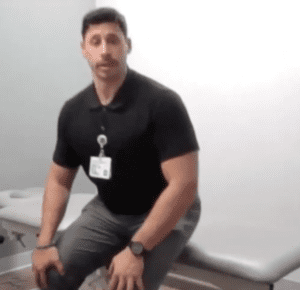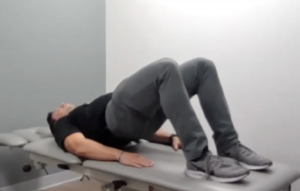If you live with a type of inflammatory arthritis, like rheumatoid arthritis, psoriatic arthritis, or axial spondylitis, you likely know that exercise is a crucial part of managing your condition — yet getting started can often feel overwhelming. You likely have a lot of questions.
- Is it safe to exercise?
- Which exercises are best to keep my joints healthy and muscles strong?
- Are there certain modifications I should try?
- Are there any exercises I should avoid?
Here, Hospital for Special Surgery (HSS) physical therapist Zack Rogers, PT, DPT, OCS, CSCS, answers patients’ top questions about exercising with inflammatory arthritis and walks you through doing several arthritis-friendly exercises. They were designed as part of a three-part video series presented by the Inflammatory Arthritis Support and Education Program at HSS for the Latinx community in collaboration with CreakyJoints Español.
Is It Safe to Exercise with Inflammatory Arthritis?
The simple answer: yes. “Motion is lotion,” says Rogers. “The more you use your joints, the easier it is to move.”
That said, you’ll want to allow yourself time to rest during and between your workouts, including rest days during the week. “Don’t push yourself too hard during times of a flare-up,” says Rogers. Try these gentle arthritis-friendly exercises to do in bed when you’re fatigued or in a flare.
And, of course, talk with your rheumatologist before starting an exercise regimen. They may recommend working with a physical therapist to get started.
How Does Exercise Help Inflammatory Arthritis?
Exercise can help with everything from fatigue to posture to weight management, as well as these two key benefits, says Rogers.
- Exercise helps improve overall function and the ability to do daily activities.
- Exercise helps strengthen muscles — and when muscles are stronger, there is less stress placed on the joints. “When there is less stress on joints, this can also help decrease pain and inflammation in the joints,” says Rogers.
Exercises using weights as well as weight-bearing exercises like walking and squats can also help combat the risk of the bone-thinning disorder osteoporosis, which can lead to frailty and fractures, adds Rogers. “If gripping dumbbells puts too much strain on your hand joints, try using cuff weights around the ankles or wrists,” he says.
What Are the Best Exercises for Arthritis?
“Walking is a great exercise — it’s free and you can do it anywhere, which is one of the reasons I love it so much,” says Rogers. Try this four-week walking program for arthritis.
A few other go-to moves to do:


Squats
- Put your arms out straight, or keep them down by your sides
- Shoot your butt back like you’re sitting in chair
- Slowly lower down and come back up
- Keep your back as straight as you can
- Perform 10 to 20 times (2 sets x 10 reps or 4 sets x 5 reps)
- Modification: If your knees are bothering you, do a smaller bend and don’t go as far down


Sitting-to-standing
- Sit from a firm, stable surface (no wheels)
- Keep your hands on your legs or use them to push off
- Stand up and sit back down slowly, keeping your back straight
- Perform 10 to 20 times (2 sets x 10 reps or 4 sets x 5 reps)
- Modification: To put less stress on your knees, place a few pillows on the surface, so you don’t have to sit down as far

Double-leg bridges
- Lie flat on your back, with your arms relaxed by your side
- Bend your knees and place your feet flat on the bed parallel to each other
- Place your hands on your sides
- Push through your feet
- Lift your buttocks in the air, and lower down slowly
- Perform 10 to 20 times (2 sets x 10 reps or 4 sets x 5 reps)
- Safety caveat: Do not lift your buttocks too high where it causes an arch in your lower back.
Are There Any Exercises I Should Avoid?
Rogers says he does not recommend the following exercises for patients with inflammatory arthritis, as they can aggravate joints in your body:
- Squat with a barbell. “Putting a barbell on your back and doing a squat can put a lot of stress on your spine. If you have inflammatory arthritis or osteoporosis, it could increase the risk of spinal fractures.
- A deadlift. Bending over at your back with your knees straight. This can increase the risk of lower back pain.
- Seated overhead shoulder press. Pushing weights overhead in a seated position could put too much stress on the shoulders, increasing the risk of shoulder pain.
“There are different ways to modify these exercises to make them more compatible for you,” says Rogers, “but you’ll want to consult a physical therapist or health care provider first before doing these moves.”
Track Your Symptoms with ArthritisPower
Join CreakyJoints’ patient-centered research registry and track symptoms like fatigue and pain. Learn more and sign up here.
Interview with Anna Balakrishnan, LMSW, Social Work Coordinator, Latino Outreach, at Hospital for Special Surgery (HSS).
Physical Activity and Inflammatory Arthritis/Actividad física y artritis inflamatoria. Inflammatory Arthritis Support and Education Program at HSS in collaboration with @CreakyJoints Español. Physical Activity and Inflammatory Arthritis/Actividad física y artritis inflamatoria (Promo)





